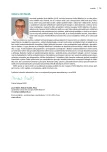Vascular age
Authors:
Ondřej Petrák; Richard Češka
Authors‘ workplace:
III. interní klinika – klinika endokrinologie a metabolizmu 1. LF UK a VFN v Praze
Published in:
Vnitř Lék 2019; 65(12): 770-774
Category:
Věk můžeme hodnotit podle mnoha kritérií. Samozřejmě, že objektivním měřítkem je kalendářní věk, který se však může lišit od biologického věku. Biologický věk pak více nebo méně koreluje s věkem vaskulárním. Pojem vaskulárního věku je založen na konstatování, že: „Člověk je tak starý, jak staré jsou jeho cévy.“ Proces cévního stárnutí začíná již od dětství. V zásadě lze na stárnutí tepen nahlížet ze dvou hledisek. Jednak je to tuhnutí tepen, ztráta jejich elasticity, jednak degenerativní změny a tvorba aterosklerotických plátů, které pak jsou příčinou ischemie, zejména v případě rozvoje aterotrombózy. Oba tyto děje můžeme monitorovat. Změnu elasticity (arteriosklerózu) zejména vyšetřováním rychlosti šíření pulzové vlny (Pulse Wave Velocity – PWV), aterosklerózu pak především neinvazivně ultrasonograficky nebo vyšetřením pomocí CT angiografie. Z klinického hlediska je potom především významné to, zda dokážeme vaskulární věk nějakým způsobem ovlivnit. V současné době existují důkazy, že aterosklerózu ovlivníme hypolipidemickou léčbou, arteriosklerózu zejména ACE inhibitory. Výše popsaná možnost ovlivnění cévního věku nás pak přivádí k dalšímu problému, a tím je kompliance nemocných. Je vynikající, že v okamžiku, kdy máme k dispozici dva léky ovlivňující vaskulární věk, můžeme využít jejich fixní kombinaci. Ta je k dispozici jako kombinace atorvastatinu s perindoprilem.
Overview
Age can be evaluated according to many criteria. Of course the objective measure is the calendar age which may differ from the biological age. The biological age more or less correlates with the vascular age. The concept of vascular age is based on the statement that “An individual is as old as his blood vessels”. The process of vascular aging already starts in childhood. Arterial aging may essentially be viewed from two standpoints. First, it involves stiffening of arteries and loss of their elasticity; second, degenerative changes and formation of atherosclerotic plaques occur, being the cause of ischemia, especially in case of the development of atherothrombosis. Both these processes can be monitored: The change of elasticity (arteriosclerosis) mainly by examination of pulse wave velocity (PWV), atherosclerosis then primarily with non-invasive methods, ultrasound or CT angiography examination. From the clinical point of view it is particularly important whether we can influence vascular age in some way. Evidence is available now that atherosclerosis can be affected by hypolipidemic treatment, arteriosclerosis then in particular by ACE inhibitors. The aforementioned possibility of influencing vascular age brings us to another problem, which is compliance of patients. With regard to that it is good that in a situation where we have two drugs affecting vascular age, we can use their fixed combination. It is available as a combination of atorvastatin and perindopril.
Keywords:
hypertension – ACE inhibitors – dyslipidemia – statins – atorvastatin – CT angiography – intima media thickness (IMT) – perindopril – pulse wave velocity (PWV) – vascular age
Sources
- American Heart Association (2014). Why Cholesterol Matters. Dostupné z WWW: <http://www.heart.org/HEARTORG/Conditions/Cholesterol/WhyCholesterolMatters/Why-Cholesterol-Matters_UCM_001212_Article.jsp>. [07–2015].
- Halcox JP, Tubach F, Lopez-Garcia E et al. Low Rates of Both Lipid-Lowering Therapy Use and Achievement of Low-Density Lipoprotein Cholesterol Targets in Individuals at High-Risk for Cardiovascular Disease across Europe. PLoS One 2015; 10(2): e0115270. Dostupné z DOI: <http://dx.doi.org/10.1371/journal.pone.0115270>.
- Gæde P, Lund-Andersen H, Parving HH et al. Effect of a Multifactorial Intervention on Mortality in Type 2 Diabetes. N Engl J Med 2008; 358(6): 580–591. Dostupné z DOI: <http://dx.doi.org/10.1056/NEJMoa0706245>.
- Jimenez JG, Rosen JB, Pirags V et al. The efficacy and safety of ezetimibe/simvastatin combination compared with intensified lipid-lowering treatment strategies in diabetic subjects with and without metabolic syndrome. Diabetes Obes Metab 2013; 15(6): 513–522. Dostupné z DOI: <http://dx.doi.org/10.1111/dom.12059>.
- Ginsberg HN, Elam MB, Lovato LC et al. Effects of combination lipid therapy in type 2 diabetes mellitus. N Engl J Med 2010; 362(17): 1563–1574. Dostupné z DOI: <http://dx.doi.org/10.1056/NEJMoa1001282>.
- Sattar N. Revisiting the links between glycaemia, diabetes and cardiovascular disease. Diabetologia 2013; 56(4): 686–695. Dostupné z DOI: <http://dx.doi.org/10.1007/s00125–012–2817–5>.
- Watts GF, Ooi EM. Balancing the cardiometabolic benefits and risks of statins. Lancet 2012; 380(9841): 541–543. Dostupné z DOI: <http://dx.doi.org/10.1016/S0140–6736(12)61301–4>.
- Van Bortel LM, Laurent S, Boutouyrie P et al. [European Society of Hypertension Working Group on Vascular S, Function, European Network for Noninvasive Investigation of Large Arteries]. Expert consensus document on the measurement of aortic stiffness in daily practice using carotid-femoral pulse wave velocity. J Hypertens 2012; 30(3): 445–448. Dostupné z DOI: <http://dx.doi.org/10.1097/HJH.0b013e32834fa8b0>.
- O’Rourke M. Mechanical principles in arterial disease. Hypertension 1995; 26(1): 2–9. Dostupné z DOI: <http://dx.doi.org/10.1161/01.hyp.26.1.2>
- [Reference Values for Arterial Stiffness’ Collaboration]. Determinants of pulse wave velocity in healthy people and in the presence of cardiovascular risk factors: ‘establishing normal and reference values’. Eur Heart J 2010; 31(19): 2338–2350. Dostupné z DOI: <http://dx.doi.org/10.1093/eurheartj/ehq165>.
- Laurent S, Marais L, Boutouyrie P. The Noninvasive Assessment of Vascular Aging. Can J Cardiol 2016; 32(5): 669–679. Dostupné z DOI: <http://dx.doi.org/10.1016/j.cjca.2016.01.039>.
- Laurent S, Boutouyrie P, Asmar R et al. Aortic stiffness is an independent predictor of all-cause and cardiovascular mortality in hypertensive patients. Hypertension 2001; 37(5): 1236–1241. Dostupné z DOI: <http://dx.doi.org/10.1161/01.hyp.37.5.1236>.
Labels
Diabetology Endocrinology Internal medicine Cardiology General practitioner for adultsArticle was published in
Internal Medicine

2019 Issue 12
Most read in this issue
- Pharmacologically induced thyreopathy in patients with cardiovascular disease
- Vascular age
- Hypertriglyceridemia and atherosclerosis risk
- Notes on the new “Recommendations for the treatment of dyslipidemia. Influencing of lipids to reduce cardiovascular risk”
